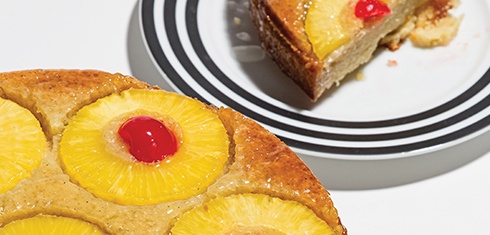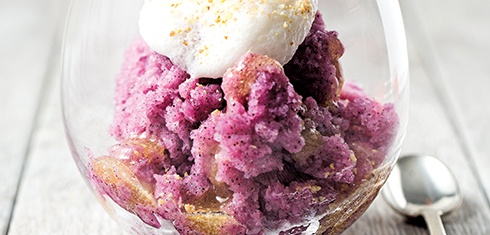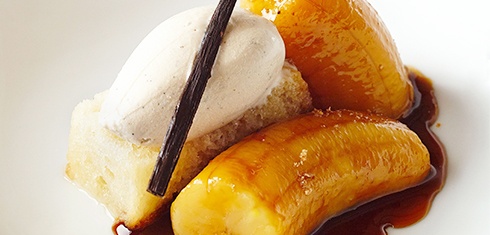Ingredients
4 lbs Granny Smith apples (about 8 medium)
1 Tbsp fresh lemon juice
½ C turbinado sugar
¼ tsp salt
½ tsp ground cinnamon
2 Tbsp plus ¾ teaspoon cornstarch
2 Tbsp plus ¾ teaspoon tapioca starch
2 Tbsp unsalted butter
1 Tbsp heavy cream
1 large egg white
Overview
Equipment
- Sous vide circulator
- Sous vide pouches
- Vacuum sealer
- Pie dough for a Deep-Dish Double Crust (use recipe in The New Pie, or any dough recipe that provides 15 ounces of dough for bottom crust and 11 ounces for top)
- 9.5-inch deep-dish pie plate
- Pie crust shield or foil
- Large saucepan
Timing
Prepping time: 3 hours 15 minutes / Cooking time: 1 hour 10 minutes (excludes sous vide cooking)
Servings
One 9.5-inch deep-dish pie
Directions
- Set up the water bath for your immersion circulator and heat the water to 155°F (68°C).
- Peel 1 apple and grate it using the coarse holes of a box grater directly into a large vacuum-sealable bag. Peel and core the remaining apples (save all the scraps) and slice them into thin wedges. Place 3 pounds of apple wedges into the vacuum bag with the grated apple. You may have a few wedges left over (snack on them while the other apples are cooking). Add the lemon juice, sugar, salt, and cinnamon to the bag with the apples and vacuum-seal it shut, being careful not to lose any of the juice from the apples in the process.
- Gather up the apple scraps and place them in a separate vacuum bag. Vacuum-seal that one, too. Cook the apples and apple scraps sous vide in the water bath for 1 hour. Remove the bag with the apple scraps and place it on the counter to cool for a few minutes. Using oven mitts or a kitchen towel, remove the bag with the apple wedges. Cut a ¼-inch hole in the bag and pour out the liquid into a 2-cup liquid measuring cup. Once all the juice has been drained, place the bag of apples in the refrigerator until the fruit is cold, about 2 hours.
- Cut a small hole in the bag with the apple scraps and squeeze additional juice into the same measuring cup with the juice from the other bag until you get 2 cups of liquid. Discard the remaining apple scraps. Cover the measuring cup with plastic wrap and allow the liquid to cool to room temperature, until you are ready to complete the pie. (The apples and apple juice can be kept in the refrigerator for up to 1 day before completing the pie.)
- Roll out the bottom pie dough to ⅛-inch thickness. Fit the dough into a 9.5-inch deep-dish pie plate. Place the pie in the refrigerator until you are ready to fill it.
- Stir the cornstarch and tapioca starch into the cooled apple liquid.
- Melt the butter in a large saucepan. Using a rubber spatula, stir the apple liquid into the saucepan and bring the mixture to a boil; after a few minutes, you’ll notice streaks of thickened juice in the liquid—don’t worry, this is the tapioca starch thickening first (tapioca starch thickens at a slightly lower temperature than cornstarch). Keep stirring; once the liquid comes to a boil, the cornstarch will thicken as well and the liquid will transform from thin and cloudy into a rich, clearer dark gel. Remove from the heat and fold in the chilled apple wedges.
- Transfer this mixture to the chilled pie crust and leave at room temperature while you prepare the top crust.
- Roll out the top crust to a ⅛-inch thickness. Place on top of the pie. Pinch the top and bottom crusts together around the edges using your thumb and fingertips. Trim off the excess.You’ll want about ½ inch of crust extending beyond the edge of the pie plate.
- Fold/roll this flap of pie dough under itself and crimp around the edge of the pie. Place the pie in the freezer for 20 minutes while preheating the oven to 425°F.
- Beat the cream and egg white together to create an egg wash. Brush the egg wash over the surface of the pie. With a sharp knife, cut 3 to 5 vents through the top crust.
- Place the pie on the lowest rack of the oven. Immediately reduce the temperature to 400°F.
- After 15 minutes, add a pie crust shield to protect the edges and rotate the pie. Bake an additional 40 minutes, rotating the pie again halfway through to minimize the effects of any hot spots in your oven.
- At this point the pie will have puffed slightly and browned. There should also be just a hint of the gelled apple juices starting to bubble through one of the vents. Stop there. Remove the pie from the oven, place on a cooling rack, and allow it to cool to room temperature before slicing. (Leftovers can be stored, covered, at room temperature for up to 3 days.)
Reprinted from The New Pie: Modern Techniques for the Classic American Dessert. Copyright © 2019 by Chris Taylor and Paul Arguin. Photographs copyright © 2019 by Andrew Thomas Lee. Published by Clarkson Potter, an imprint of Penguin Random House, LLC.
Related RecipesView All Recipes
Sous Vide Pineapple Upside-Down Citrus Cake
 Intermediate
IntermediateA mid-century-modern favorite gets a sous vide update with this innovative take on pineapple upside-down cake.
Dragon Fruit Granita
 Intermediate
IntermediateThis tangy and tropical granita, made with eye-catching dragon fruit, will jolt your tastebuds awake and teach you some serious new sous vide tricks.
Jordi Roca's Banana Flambé
 Intermediate
IntermediateThe three-star Michelin chef shared his recipe exclusively for Sous-Vide’s online readers.
Buy the Magazine
Buy NowDedicated to the Art & Science of Sous Vide
The first publication devoted to the art and science of sous vide cooking, featuring innovative recipes, visual inspiration, expert techniques for cooking sous vide at home, and exclusive interviews with world-class chefs.

 Intermediate
Intermediate


